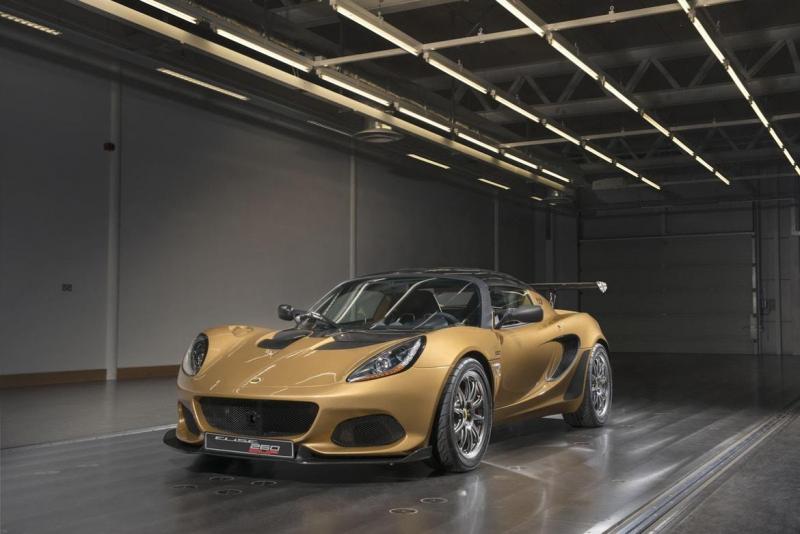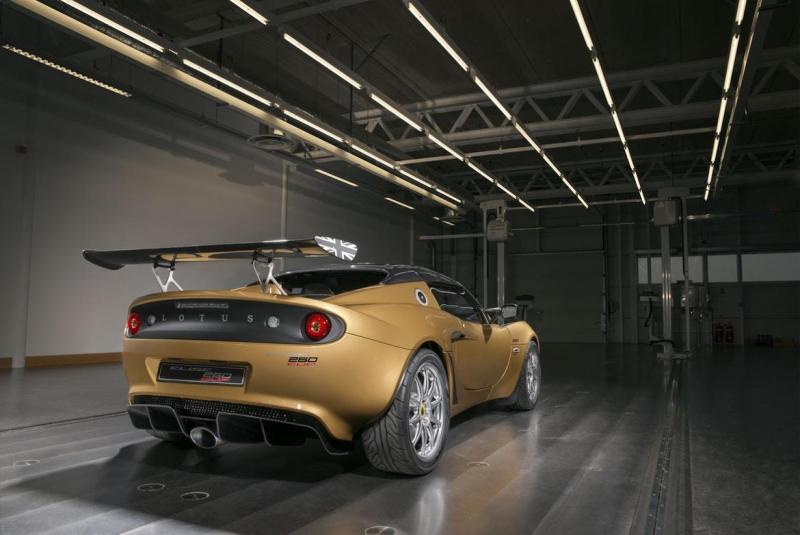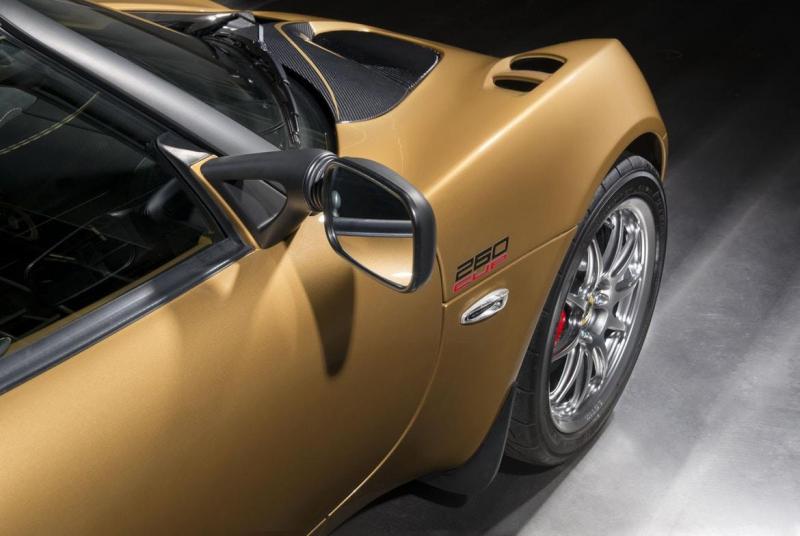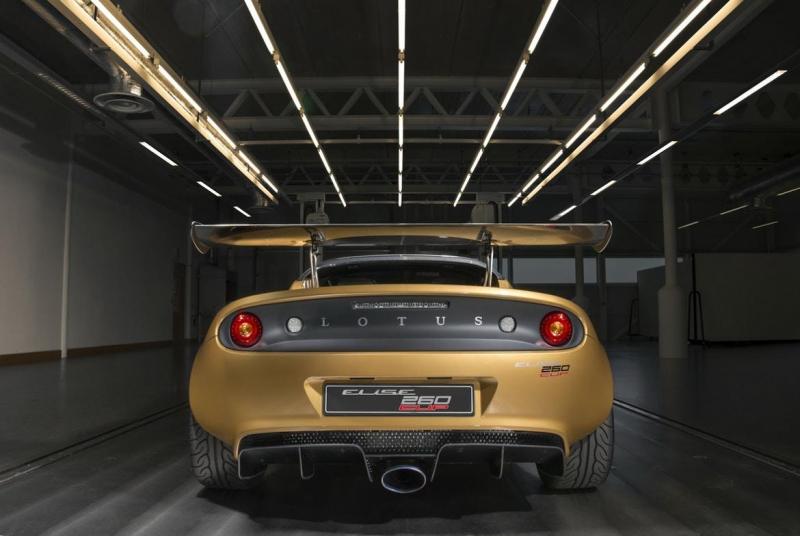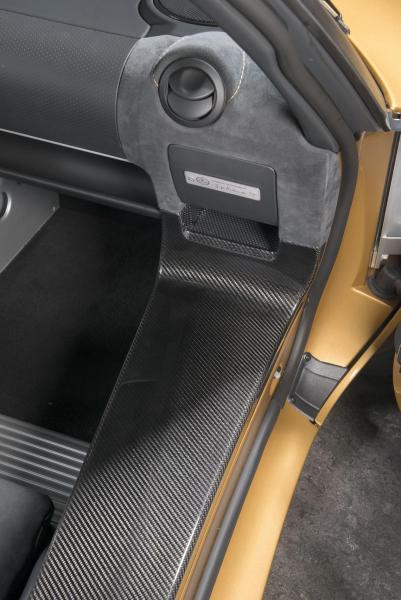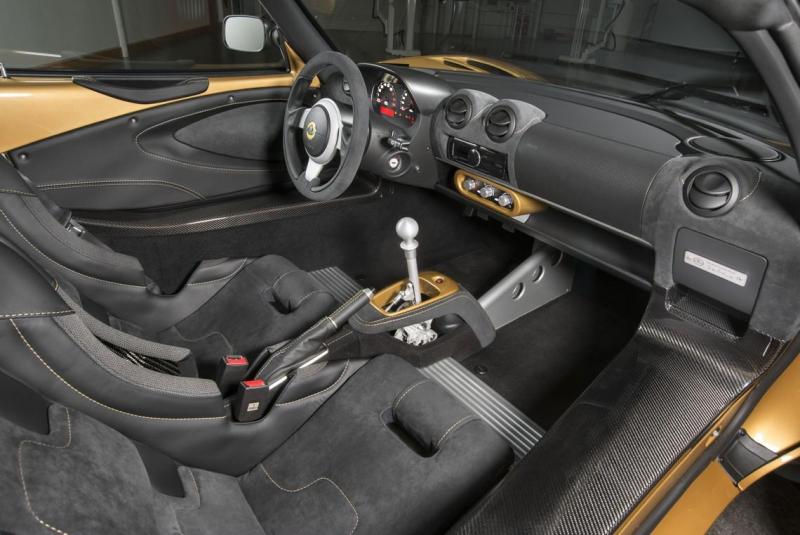Cerca nel Forum
Mostra i risultati del/dei TAG ''lotus'' .
Trovato 63 risultati
-

Lotus e Williams siglano un contratto di collaborazione
nella discussione ha aggiunto Beckervdo in Notizie e Scelte Strategiche dal mondo dell'Auto
Lotus Engineering e Williams Advanced Engineering inizieranno a lavorare insieme. Lotus contribuirà con le proprie conoscenze sui materiali e sulle strutture leggere, Williams fornirà la tecnologia per le trasmissioni elettriche e la tecnologia delle batterie - tra cui quelle per il campionato Formula E . Tuttavia, non si tratta di una fusione, entrambi funzioneranno in maniera indipendente. "La collaborazione fa parte della nostra strategia per acquisire una maggiore conoscenza di un settore automobilistico che sta subendo rapidi cambiamenti", afferma il CEO di Lotus Cars, Phil Popham. Craig Wilson, CEO di Williams Advanced Engineering, ritiene che, insieme a Lotus, verrà sviluppata la prossima generazione di trasmissioni e propulsori. Via Teknikensvarld -

Phil Popham, ex di JLR, a capo di Lotus
nella discussione ha aggiunto Beckervdo in Notizie e Scelte Strategiche dal mondo dell'Auto
Via Carscoop -
PRESS RELEASE
- 1 risposta
-
- 2
-

-

-
- auto in arrivo
- novità auto
-
(e 18 altri in più)
Taggato come:
-
Autocar.co.uk Nuova variante dell'Evora: +10hp, -70Kg
-
- 6 risposte
-
- 1
-

-
- auto in arrivo
- novità auto
- (e 15 altri in più)
-
New engine installation, delivering 430 hp and 440 Nm •New design generating 220 kg of downforce •407 hp per tonne provides unrivalled performance •0-60 mph in 3.2 secs, dry weight from 1,056 kg Unlimited in every sense, the new series production Exige Cup 430 is Lotus’ wildest incarnation of its fire-breathing, point-to-point two-seater sports car. New to the Exige, the Cup 430 sees the introduction of a savage, high-performance engine installation, mated to a new supercharger and chargecooler, designed specifically for the unique demands of this vehicle. A development of the powertrain recently used on the phenomenal Lotus Evora GT430, it’s perfectly paired with a newly-designed body, which delivers enhanced aerodynamic performance to reveal the model’s true potential. The result is a strikingly different beast of pure performance, that’s not for the faint of heart.With 55 hp, or 13%, more power than the limited production Exige Cup 380 model it succeeds, and 220 kg of downforce, it’s a monster of a car. Compared to the Exige Sport 350, it has 24% more power and generates the same downforce at 100 mph as the Exige Sport 350 does at its maximum speed of 170 mph. Lotus’ expertise in lightweight design has played its part in reducing the overall dry weight by 12 kg to 1,059 kg, with the vehicle down to 1,056 kg in its lightest configuration. This, combined with the dramatic jump in raw power, raises the Cup’s power to weight from 355 hp / tonne (Cup 380) to 407 hp / tonne. With 430 hp at 7,000 rpm and 440 Nm (325 lbft) of torque from 4,000 rpm, 0-60mph is dispatched in 3.2 seconds (0-100 km/h in 3.3 seconds) with a top speed of 180 mph (290 km/h). Helping to harness all that power, the Cup 430 benefits from a comprehensive range of new aero elements. A new ultra-lightweight front clam with unique carbon fibre ducts has wider radiator apertures and a new mesh pattern grille to provide a more combative aspect and to allow for a new front splitter and air curtain mechanism to reduce drag. The lightweight rear clam panel supports the larger, straight motorsport wing to increase downforce without impacting upon the car’s overall drag coefficient. The new design front and rear clam panels are 6.8 kg lighter than those on any other Exige. Focused fairly and squarely on aggressive track performance and point-to-point supremacy, the new Lotus Exige Cup 430 is capable of covering the Hethel circuit in 1 minute 24.8 seconds – the fastest production car to lap the famous circuit – 1.2 seconds faster than the Lotus 3-Eleven (Road). Jean-Marc Gales, CEO, Group Lotus plc said, “This is the car that we have always wanted to build, and I am sure that all Lotus enthusiasts will be delighted with the end product. As well as a significant power hike, the Cup 430 has benefited from extensive development in areas essential to Lotus’ DNA, in order to ensure that the full potential of the Exige’s incredible chassis can be exploited. This car has no rivals – inside or outside of its price bracket - and it’s no exaggeration when we say that nothing can keep up with this Exige on the road or track.” Lotus Exige Cup 430 – carbon based light form Lotus’ most extreme Exige packs the company’s most potent powertrain into its smaller vehicle architecture to provide a level of performance that is a step beyond what most drivers can exploit. The car’s distinctive and aggressive new styling perfectly matches the character of the new Exige Cup 430. Signaling the most motorsport focused models in Lotus’ range, the Cup variants are centered on only the essential. Extending this philosophy to its limit, the new Cup 430 is at the apex of the Exige line-up – with only a track-only racer capable of exceeding the car’s abilities. With the Exige already regarded as the standard for purity of purpose, Lotus’ engineers have built upon this benchmark, ensuring that the application of more power is complemented by a class-leading handling balance, characterised by precision and tactility. At the heart of the car lies Lotus’ most formidable engine, a 3.5-litre supercharged and charge cooled V6 producing 430 hp and 440 Nm. Unapologetically aggressive, the Exige Cup 430’s 220 kg of downforce is developed through the careful management of airflow under and over the car. Vital in keeping the Cup at the top of timing sheets, it’s designed to make the most of 440 Nm (325 lbft) of torque delivered from 4,000 rpm, and delivering the lowest of lap times not matter the track. This not only includes the new front clam panel, incorporating a new design of splitter and carbon fibre air blades, but also the high mounted rear wing. The new body introductions combine form and function, with the new hybrid carbon composite panels not only saving weight, but also delivering the car’s distinctive new styling and aerodynamic set up. Balancing downforce over the entire car was a priority with, when compared to the Exige Cup 380, a greater percentage of downforce allocated to the front to ensure accurate high-speed turn in (36% increased to 45%). The new front splitter with trailing lip helps separate and speed airflow under the car and the inclusion of new air curtain elements into the front clam panel efficiently moves air though to the front wheel cavities to help reduce turbulence and drag generated by the front wheels. The front louvers reduce the pressure within the front wheel arches, increasing downforce. The cut-out sections behind the rear wheels, also reduce wheel arch pressure, whilst the new lightweight aluminium diffuser is 1 kg lighter. Crowning all of this is the carbon fibre straight rear wing, raised higher to further boost downforce, clearly signaling the car’s aggressive intent and pursuit of aerodynamic excellence. As you would expect, the intense use of ultra-lightweight carbon fibre only adds to the overall performance, as well as reinforcing the Exige Cup 430's physical presence. The hand-made composite components include front splitter, front access panel, roof, diffuser surround, large aperture air-intake side pods, one-piece tailgate and the race derived rear wing. Scratch the surface of the Cup’s capabilities, and you’ll find its motorsport-derived credentials. In addition to revised steering arm geometry, to increase bump steer, the car’s handling characteristics can be altered via the introduction of new Nitron three-way adjustable dampers (adjustable for rebound and low and high-speed compression, giving the ability to fine tune the damping) and Eibach adjustable front and rear anti-roll bars, both as standard. The substantial Michelin Pilot Sport Cup 2 tyres (215/45 ZR17 front and 285/30 ZR18 rear) are fitted to ultra-lightweight forged alloy wheels, available in red, black or silver as standard. The faster the car, the better the brakes need to be, and the Exige Cup 430 uses some of the largest calipers and rotors of any Lotus road car. With forged, four-piston AP Racing brake calipers and new performance two-piece, J-hook brake discs (with higher thermal capacity) front and back, the system is designed to give improved bite and debris clearance and reduce distortion and vibration and to deliver consistent pedal feel and stopping power lap after lap. The Cup 430 also comes with a tremendously strong, yet light, T45 steel roll over bar, new seatbelt anchorage frame (saving 1.2 kg), a Lithium-Ion battery and front towing eye as standard, as well as a host of options including, a dealer fit FIA compliant roll cage, electrical cut-off and fire extinguisher controls, airbag deletion and a non-airbag steering wheel. Key to the Cup’s potency is the Exige’s newly-developed powertrain. Based on the benchmark engine from the recently launched Evora GT430, it features an Edelbrock supercharger and water to air charge cooler to generate more power through cooling the higher pressure charged intake air. Specifically developed for the Exige, the engine’s calibration allows for a redline of 7,000rpm, helped in part by a new intake system and larger throttle body. In order to handle the extra power, a new oil cooler configuration and uprated clutch are required. Available as standard with a close-ratio, six-speed manual transmission, the Exige range features Lotus’ acclaimed open-gate manual gearbox design. Precisely aligned for fast and seamless shifts, it has recently established itself as a favourite of Lotus customers. To transfer the increased power and torque from the engine to the gearbox, a new 240 mm diameter clutch has been fitted (up 12 mm compared to the Exige Cup 380) which increases the clutch surface area by 11%. Engine note and tone also play big parts in the Cup’s repertoire. With the new induction and supercharger configuration, and a high-flow titanium exhaust system as standard, the Cup 430 sounds like no other Exige at speed. In addition, the titanium exhaust removes 10 kg from beyond the rear axle, The Lotus Exige Cup 430 includes a variable traction control function, linked directly to the ECU. The six-position rotary switch is located on the steering column, and only active with ESP switched to off, with five pre-set traction levels (1%, 3%, 6%, 9%, 12% slip) as well as “off”, displayed via the instrument cluster. The composite concept continues into the Cup’s cabin with visible-weave, handmade sections including a new lightweight carbon fibre binnacle surround, Lotus’ bespoke carbon race seats, with new lightweight seat runners, and carbon door sills. Colour keyed inserts for the revised lightweight sports seats, transmission console, HVAC surround and window switches are also standard, along with a centre console, door cards and dashboard trimmed in Alcantara®, with leather or tartan as a no cost option, along with contrast stitching and an Alcantara® steering wheel. In total, the lightweight interior of the Exige Cup 430 is 2.5 kg lighter than on the Cup 380. All the lightweight standard items help reduce the total mass by 29 kg which more than offsets the increase in weight from the chargecooler and cooling system (+15 kg), new higher rated clutch (+0.8 kg) and wider brake discs (+1.2 kg) resulting in an unladen weight of 1,093 kg and 1,059 kg dry. By selecting the airbag deletion option, the customer can take the lightest possible dry weight of the Exige Cup 430 to 1,056 kg. For owners wanting to brand the new Exige their own, the Cup 430 can be personalised through Lotus’ Exclusive programme. Combining traditional British craftsmanship with modern design, the service inspires customers to spend time tailoring the character of their Lotus with a comprehensive array of options. Since its introduction this has proved increasingly popular, with over 25% of all new cars undergoing some form of personalisation. Launching the new Lotus, Jean-Marc Gales said, “The Exige continues to push the boundaries of what is possible in terms of performance, agility, aerodynamics and rapid covering of ground from A to B in a production road car. There isn’t another car on sale that can match the new Exige Cup 430; it will go down as a ground-breaking car in the history of Lotus.” The Exige Cup 430 is available as a series production car and can be ordered now, priced £99,800 including VAT (UK) and €127,500 (Germany) and €128,600 (Franc
- 12 risposte
-
- auto in arrivo
- novità auto
- (e 16 altri in più)
-
Precision, beauty and performance: The new Lotus Evora GT430 Thursday, July 20, 2017 - 13:00 Most powerful road going Lotus sports car ever • 0-60 mph in 3.7 secs, 430 hp and 1,258 kg • 250kg of downforce at maximum speed of 190 mph • Just 60 editions planned for worldwide markets • Available to order now Following the successful introduction of the Lotus Evora 400 and Evora Sport 410 to global markets, Lotus has unveiled its most powerful road-going model ever - the Evora GT430. A beautiful and pure combination of elegance and power, Lotus has lavished attention on hand crafted carbon-fibre components to endow this fully homologated Evora with a level of precision engineering and design unseen before. This focused evolution of the critically acclaimed Evora has resulted in a landmark model for the famous British manufacturer. Powered by a new development of the 3.5-litre V6 supercharged and charge cooled engine producing 430 hp, and benefitting from a significant hike in downforce, the rare breed Evora GT430 is a class apart from its competitors. Underpinned by the company’s acknowledged eminence in lightweight engineering, and at a new benchmark weight of 1,258 kg (dry), the Lotus Evora GT430 is the manufacturer’s most powerful and accomplished road car to date. With such performance, and all the marque’s chassis expertise, the new Evora GT430 delivers tremendous real-world speed and handling unheard of in its class. Given the car’s breath-taking design and phenomenal performance, the Evora GT430 is an instant classic. Just 60 editions of this supreme Evora will be hand built in Norfolk, England, for sale in select markets around the world and, following the popularity of Lotus’ recent limited run editions, it’s already in line to be a true collector’s car. Marking the return of a famous Lotus badge, and acknowledging the Lotus Esprit V8 GT and the Esprit GT3 from the 1990s, this two-seater encapsulates the company’s approach to fast point-to-point sports cars. 0-60mph is dispatched in just 3.7 seconds and the car’s top speed is 190 mph (305 km/h). With new and specifically designed body panels, featuring exposed carbon weave sections, front and rear, the Lotus GT430 generates up to 250 kg of downforce through advanced aerodynamics. Larger front apertures, a new carbon fibre splitter, air blades and louvers positioned on top of each front wheel arch clearly illustrate the supercar credentials of the Evora GT430 when viewed head on. At the rear, aero ducts behind each wheel reduce pressure in the wheel arch and offer visibility of the wider Michelin Pilot Sport Cup 2 tyres, and a large rear diffuser provides a sharp visual finish. Both are crowned by the large, profiled carbon wing. Jean-Marc Gales, CEO, Group Lotus plc said, “The Evora GT430 is a landmark car for Lotus. Lightweight engineering and class-leading handling, paired with Lotus’ aerodynamic expertise, define the Evora GT430 as a legendary Lotus. It’s a truly beautiful car, meticulously finished in hand-crafted carbon, and employing the latest aerodynamics and lightweight materials. This highly developed vehicle perfectly reflects Lotus’ attention to engineering and design. We expect the lucky owners to be blown away by its pure presence and staggering performance.” Faster, lighter, sharper Featuring unique bodywork and aerodynamic elements, as well as more power, the Evora GT430 further raises the bar for road-going sports cars. It delivers the balance and finesse for which the marque is famous, combined with blistering pace, supreme composure and agility at the highest speeds. Every component of the Evora has been evaluated before inclusion to ensure that the car retains only the items essential for performance. Despite the addition of 9 kg increased specification components (lightweight carbon rear wing and larger wheels and tyres), overall dry weight is down by 26 kg, to 1,258 kg, compared to the already super light Evora Sport 410, making this the lightest road Evora to date. In addition to the unique full carbon front and rear bumpers, which feature exposed visible weave sections, the car is comprehensibly equipped with high-gloss, visible carbon fibre components throughout, including a new front splitter, front access panel, roof panel and full width rear wing. Also at the rear is a beautifully detailed, one-piece carbon tailgate, incorporating a louvered section which, together with composite quarter panels, affords the car an unmistakable profile. All Lotus cars are regarded as the finest handling sportscars on the market and the new Evora GT430 takes dynamic performance to the next level. Damping is provided by Lotus-tuned, Öhlins TTX two-way adjustable units, with twenty click-adjustment compression and rebound settings and saving 10kg in mass compared to the Evora Sport 410 set-up. New, ultra-lightweight, low-sideload Eibach springs provide an increase in spring rate and the car’s handling is improved further through the use of front and rear anti-roll bars. Perfect for B-roads, but ballistically fast when needed, the new Evora GT430 can lap the famous Hethel test track in 1 minute 25.8 seconds – a record for an Evora. As fast as the famed Lotus 3-Eleven Road car on the same circuit, the GT430’s performance envelope is derived from a combination of clever aero and dynamic developments as well as outright power. As a result, the car is manifest of Colin Chapman’s visionary quote: “Adding power makes you faster on the straights; subtracting weight makes you faster everywhere." A superb example of this is the removal of critical weight from beyond the front and rear axles of the Evora GT430, reducing the car’s polar moment of inertia, resulting in improved transient response, overall agility and driver feedback. Retaining a 3.5-litre supercharged and charge cooled V6, the car’s reconfigured engine produces 430 hp (436 PS) at 7,000 rpm and 440 Nm (325 lbft) of torque from 4,500 rpm. The increase in torque is facilitated through the introduction of an air-to-liquid gearbox cooler as standard, a feature which made its debut on the recently launched North American Evora 400. As standard, the Evora GT430 also features a titanium exhaust, cutting 10 kg from beyond the car’s rear axle and further amplifying the car’s aural presence. Also fitted as standard, the Evora GT430’s six-speed manual gearbox features a low-inertia, single-mass flywheel, to help ensure swift changes, while a Torsen-type limited slip differential (LSD) gives better traction, and faster exit speeds, when cornering. The substantial aerodynamic revisions introduce bodywork elements that boost the downforce of the Evora GT430, up to 250 kg at maximum speed of 190 mph (305 km/h) and matching the Evora Sport 410’s maximum downforce of 64 kg at only 90 mph (145 km/h). Developed through motorsport applications, the aerodynamic modifications focus on the management of airflow over, under and around the car. The downforce generated makes its presence felt at even moderate speeds, allowing for higher cornering g-force and providing enhanced high-speed stability. A new carbon fibre front splitter cleanly separates and speeds airflow under the car, and the two enlarged carbon fibre front ducts, with integrated air blades, efficiently move air though to the front wheel cavities, to help reduce turbulence and drag created by the wheels themselves. The lightweight curved rear edges of the front wheel arch panels channel air along the side of the car and the louvers positioned on top of each front wheel arch reduce pressure above the wheel. The rear of the Evora GT430 has received the same attention to detail, with the deep, sculpted ducts behind each wheel that vent airflow as quickly as possible from the wheel arches, improving downforce. Dominating all of this is the large, high mounted aerodynamically efficient motorsport carbon wing. To harness the increased downforce and power, mechanical grip is provided by 10 mm wider Michelin Pilot Sport Cup 2 tyres, with 245/35 R19 at the front and 295/30 R20 at the rear, on one inch wider 10.5J rear wheels. Ultra-lightweight forged aluminium wheels are standard, in either black or silver, with optional finishes available in gloss red or a gloss black machined rim design. Dynamic stability modes (with ‘Drive‘, ‘Sport’, ‘Race’ and ‘Off’ settings) can be selected, which allow the driver enhanced vehicle control before the system intervenes. The Evora GT430 also includes a newly developed variable traction control function, linked directly to the ECU, which allows the amount of wheel slip to be set by the driver whilst in ‘Race / Off’ setting, with five pre-set traction levels (1%, 3%, 6%, 9%, 12% slip) and ‘off’ displayed via the instrument cluster. A fast car requires substantial stopping power, and the Evora GT430 uses 2-piece J-grooved and ventilated brake discs at the front, paired with Autopareri.com Racing four-piston calipers all round, while the rear uses 3-piece discs with lightweight aluminium centres saving 2 kg. “Lotus is famous for using its technical expertise to develop the lightest engineering solutions,” explained Jean-Marc Gales. “Yes, it is hugely powerful but, the GT430 is not about brutal performance. It’s an intricate balance of power, finesse and road holding, no matter the speed, and is a true track-and-back sports car, supremely focused and immensely fast.” The external theme of carbon continues into the car’s exquisitely crafted cabin, with visible-weave, handmade components as standard. These include Lotus’ beautifully detailed carbon race seats, new carbon door sills and a new lightweight carbon instrument binnacle cover with a new design of graphic on the instrument panel. Newly-designed carbon-backed Sparco seats with a unique trim design can also be ordered, whilst customers looking for a more race focused cabin can specify an optional driver and passenger four-point harnesses and titanium rear frame. The steering wheel, dashboard, door panels, transmission tunnel and centre console are all trimmed in a combination of black Alcantara® and perforated leather, with a full leather or full Alcantara® trim option available at no additional cost. All trim choices are complemented by contrast twin colour stitching, in red and white, and matt black interior panels. An integrated touch-screen infotainment system can be specified, including iPod® connectivity and Bluetooth® functionality, satellite navigation and reversing camera. Every new Lotus Evora GT430 customer can personalise their vehicle through the increasingly popular Lotus Exclusive programme. Developed by the Lotus Design team, roughly a third of all new Lotus cars now undergo some form of customisation. Conceived to inspire customers, it combines traditional British craftsmanship with the best of modern design, and allows owners to tailor vehicles to their personal taste. The new, fully homologated, Lotus Evora GT430 is available in two seater configuration only and can be ordered now. A version of the Evora GT430 for the North American market will follow in spring 2018. Weight reduction in detail The headline net weight reduction of 26 kg versus the Evora Sport 410 is derived from the standard titanium exhaust (-10 kg), carbon body panels (-4.7 kg), lightweight interior components (-2.5 kg), Öhlins and Eibach adjustable spring and damper assembly (-10 kg) and lightweight rear brake discs (-2 kg). Additionally, careful attention to detail beneath the car’s surface has yielded significant benefits, further stripping out unnecessary mass; for instance, a thinner aluminium undertray (1.5 kg), the introduction of lightweight aluminium brackets (-1.3kg), lightweight polycarbonate backlight glass (-0.5 kg) and a re-profiled fluid fill system (-2.5 kg) all contribute towards the total weight reduction. This total saving of 35 kg is offset by the addition of wider wheels and tyres (+5 kg) and the new curved profile rear wing (+4 kg). via lotuscars.com
- 13 risposte
-
- 1
-

-
- sondaggio
- auto in arrivo
- (e 12 altri in più)
-
Nuova veste , essenzialmente aerodinamica dell'exige 380. https://www.thelotusforums.com/latest-news/lotus-cars-news/lotus-reveal-exige-cup-380/ ][
- 27 risposte
-
- sondaggio
- auto in arrivo
- (e 13 altri in più)
-
Elise Sport Elise Sprint PRESS RELEASE via www.lotuscars.com Che dire, nuovo clam anteriore,dietro fascia exige sport 380 con solo 2 fanali torretta cambio nuova, modifiche di dettaglio che andranno in gamma "regolare" nel tempo. Non male dai.
- 21 risposte
-
- 2
-

-
- sondaggio
- auto in arrivo
- (e 14 altri in più)
-
Messaggio Aggiornato al 01/12/2015 Press Release : Lotus Prezzo: ------
- 6 risposte
-
- elise s cup 2015
- lotus
- (e 4 altri in più)
-
Messaggio Aggiornato al 21/08/2015 carscoops Press Release: Lotus Prezzo: ----- Nuovo suffisso per l'Evora facelift, il cui 3.5 V6 raggiunge i 400 CV. Modifiche estetiche a dir poco oscene, imho. In compenso perde 22 kg rispetto al passato.
- 26 risposte
-
- evora 400 2015
- ginevra
- (e 5 altri in più)
-
carscoops Press Release: Lotus In periodo di vacche magre, Lotus presenta un sempre interessante upgrade Cup per la Exige (soltanto 50 esemplari). Il 3.5 V6 è adesso capace, come avrete capito, di 360 CV, il ché le permette di compiere lo 0-100 in meno di 4 secondi.
- 6 risposte
-
- exige
- exige 360 cup 2016
- (e 4 altri in più)
-
- 8 risposte
-
- convertible
- evora
- (e 5 altri in più)
-
carscoops Presentazione a Goodwood per la 3-Eleven. V6 3.5 (Toyota) sotto il cofano, cambio manuale a 6 marce, 900 kg di peso e 0-100 in circa 3 secondi. Mi piace un sacco
- 15 risposte
-
- 3-eleven
- 3-eleven 2015
-
(e 4 altri in più)
Taggato come:
-
Lotus Evora 2014 - 22 August 2014 - Autogespot spottato un esemplare di prova della Evora 2015. Da voci sembrano confermate modifiche estetiche , e alcuni danno per possibile novità nei motori (eu6?). VOci da uk si parla anche di uscita dal listino delle versioni N/a 280cv.
- 7 risposte
-
- evora facelift spy
- lotus
-
(e 2 altri in più)
Taggato come:
-
Messaggio Aggiornato al 21/08/2015 ØØØØØØØ/img37/7318/10264416612066016114.jpg' alt='10264416612066016114.jpg'> WCF Press Release : Lotus Prezzi: ----- Tutti quelli che s'aspettavano l'Evora Roadster rimarranno delusi, han preferito scoperchiare l'Exige. Nulla da ridire, comunque.
- 18 risposte
-
- exige
- exige s roadster
- (e 6 altri in più)
-

Lotus Elise Club Racer S (Foto Ufficiali)
nella discussione ha aggiunto nicogiraldi in Presentazioni Nuovi Modelli
Nuova versione per l'elise Supercharged la clubracer, allestimento ripreso dalla entry level 1600. La versione CR della Elise è stata un grande successo sin dalla sua prima appararizione: una Elise più leggera, più essenziale e minimalista nella più pura filosofia Lotus. Ora la Elise più amata diventa più performante che mai grazie al nuovo propulsore 1.8 con 220 cv e ben 250Nm di coppia. La CR-S disponibile dal model year 2014 sarà la Elise più performante mai realizzata fino ad oggi: sospensioni Bilstein più sportive con molle Eibach ottimizzate per l’uso più sportivo in pista, barra antirollio regolabile, riduzione del peso fino a 29 Kg, Power Pack CR-S 230cv con scarico alleggerito e aspirazione sportiva per ottimizzare coppia e potenza. Il risultato è un rapporto peso potenza di ben 257 cv/T. Il programma “Sport” selezionabile” con il comando sulla console centrale è pensato per l’uso più sportivo: la spia “Sport” si illumina sul quadro strumenti e la percezione di maggiore sportività si avverte subito: il regime massimo di giri disponibile aumenta, la reazione dell’apertura della valvola a farfalla è immediata, la soglia dei controlli di stabilità viene ridotta per passare al pilota maggior controllo nell’uso in pista e l’accelerazione da 0 a 100 km/h avviene in appena 4,5 secondi. Esteticamente la classica livrea CR viene esaltata da nuovi colori più brillanti e vistosi realizzati in esclusiva per la versione più potente della versione CR ,dove risaltano i particolari in nero satinato e i bellissimi sedili con il guscio in materiale composito verniciati in tinta con la carrozzeria. Prezzo 46.800 Euro compresa IVA 21% e trasporto (messa in strada e IPT escluse),disponibile in 6 nuovi colori a partire da Ottobre 2013. Da notare che con gli optional obbligati (condizionatore+soft top) si è sotto la fatidica quota dei 50K, mentre ora una S con due pack viene sui 55.- 2 risposte
-
- elise club racer s
- lotus
- (e 3 altri in più)
-
Nasce la Lotus Motorcycles: presto arriverà la C-01 Link a caso, la fonte originaria risiede su Facebook: https://www.facebook.com/LotusMotorcycles In breve: nasce Lotus Motorcycle, una branca a 2 ruote di Lotus. Presto verrà presentata la C-01, motorazza formata da una leggera crosta di titanio e fibra di carbonio farcita da un motore da circa 200 cv. Obiettivi dichiarati: i modelli SBK di varie case motociclistiche... Lotus svilupperà un motore tutto suo? NUN CREDO! non lo fa per le 4 ruote, perché dovrebbe farlo per le 2? Allo stile c'è Daniel Simon ex VW, ex Tron, ex Oblivion Nel team per lo sviluppo teNNico c'è di mezzo Kodewa GmbH, team tedesco... la moto verrà industrializzata e prodotta da Holzer Group Quindi si tratterà in definitiva di una moto dalla nazionalità tedesca con solo un vago sentore anglomalese, per cui non mi aspetto di certo un figurino snello alla Norton o Triumph ma una megamoto ipertrofica (magari illuminata al neon... ) La cartella stampa recita così:
-
Messaggio Aggiornato al 21/08/2015 autoweek.nl - carscoop Press Release :
- 41 risposte
-
- exige s 2011
- lotus
-
(e 4 altri in più)
Taggato come:
-

Abarth/Alfa Romeo/Lancia/Fiat Dino - Coupè a Motore Centrale (Notizie)
nella discussione ha aggiunto Xenophon in Scoops and Rumors
Da Italiaspeed via autoblog.it Fiat Group Automobiles is preparing to unleash a trio of niche sports cars in 2010 for its Alfa Romeo, Abarth and Lancia brands, each boasting high performance and light weight characteristics, and all based on dedicated new platforms. The three sports cars are additions to the outlined FGA product portfolio and are set to be low-volume halo cars that will adhere to each brand’s underlying principles. Each one is set to excite fans of the respective brands and will be designed to thrill the driver. Lancia and Alfa Romeo will each get a sports coupe based on an all new rear wheel drive platform, while Abarth will get a two-seat rear wheel drive sports car, on separate architecture to the former two. All three cars will be launched in 2010 and will break with the current pattern that has seen FGA models getting heavier and heavier. The Lancia coupe will be based around the very well received Fulvia showcar which made such a splash when it debuted at the Frankfurt IAA in the autumn of 2003. Fiat bosses in the intervening half decade have tried many options to realise this model, even going as far as weighing up basing it on the ‘Premium’ platform as used by Alfa Romeo’s 159 saloon and Brera coupe. However, seven years after it first stunned onlookers at the German motor show it is set to arrive in the showrooms, underpinned by an all new RWD platform, no details of which have emerged yet. This new platform will be shared by a new-sports coupe planned for Alfa Romeo which will also arrive the same year, 2010, the year the brand will celebrate its centenary. Also adhering to weight saving principles it is expected to revive the legendary Giulia/Giulietta name. There is speculation that the RWD platform could be bought in by Fiat for these two applications. The third sports car to arrive in the showrooms that year (2010) will be from Abarth. This however will be a rear engined, two seat sports car that will be a direct competitor for the Lotus Elise. Ultra-lightweight, and to be powered by FGA’s growing range of small capacity turbocharged engines, it will draw on all Abarth’s historical DNA. Prospective Abarth dealers were guaranteed a small sports car when they signed up to the new network and Abarth is on course to remain on this target. The new Abarth sports car will be assembled by hand at Abarth’s ‘Officine 83’ headquarters at Mirafiori, Turin, with the lightweight chassis being built by an outside supplier and shipped in. Abarth has investigated the principles of the Lotus Elise closely and it is believed that management have discussed buying the lightweight chassis which uses advanced bonding techniques. Lotus has had much success adapting the Elise theme to external clients, having rebodied it for GM’s Vauxhall/Opel brands as well as for the innovative electric-powered Tesla sports car. Fiat group has also gained much experience of niche composite chassis manufacturing in its own research divisions, while another option being weighed up would be for ATR to build the chassis. One of the world leaders in lightweight material chassis manufacturing, ATR has built the tubs for supercars such as the Ferrari Enzo, Maserati MC12, Porsche Carrera GT, Lamborghini Murciélago and Bugatti Veyron. N.B. il grassetto è mio- 440 risposte
-
- abarth
- alfa romeo
-
(e 5 altri in più)
Taggato come:
-

Lotus Evora GTE (Foto Ufficiali)
nella discussione ha aggiunto Touareg 2.5 in Presentazioni Nuovi Modelli
autoblog.it- 20 risposte
-
- concept
- francoforte
-
(e 4 altri in più)
Taggato come:
-

Lotus Esprit Concept (Foto Ufficiali)
nella discussione ha aggiunto Touareg 2.5 in Presentazioni Nuovi Modelli
autocar.co.uk es.autoblog Mamma mia che favola.. sono sconvolto da Lotus..- 34 risposte
-
- concept
- esprit concept
-
(e 5 altri in più)
Taggato come:
-

Lotus Evora S Freddy Mercury Special Edition (Foto Ufficiali)
nella discussione ha aggiunto davbs in Presentazioni Nuovi Modelli
in occasione del 65° compleanno di Freddie Mercury (che non necessita di presentazioni), a Londra è in programma una manifestazione in suo onore, intitolata 'Freddie Mercury For A Day'. Nell'ambito di questa, verranno messe all'asta una serie di oggetti. Il ricavato dell'asta sarà donato in beneficenza al Freddie Mercury Phoenix Trust, che si occupa di prevenzione contro l'Aids. a detta asta partecipa anche la Lotus, con una edizione speciale e particolare della vettorua EVORA S, che di cui vi posto qualche immagine.. l'auto pare non abbia ricevuto modifiche meccaniche ma solo estetiche. Che dire, un bel gingillo- 10 risposte
-
- evora s fm special edition
- fm special edition
- (e 5 altri in più)
-
LLN A quanto pare dicono stian tentando di metterle un V6..
- 28 risposte
-

Lotus Elan Concept (Foto Ufficiali)
nella discussione ha aggiunto Touareg 2.5 in Presentazioni Nuovi Modelli
autocar.co.uk autocar2013, stupenda.- 56 risposte
-
- concept
- elan concept
-
(e 5 altri in più)
Taggato come:

.thumb.jpg.d20c5008a881490f9c7f843d442a34f8.jpg)

